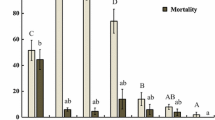Abstract
Six different bioassay methods were evaluated using propargite (Omite 30% wettable powder (WP) and fenbutatin oxide (Torque 50% (WP) and 55% suspension concentrate (SC)) with twospotted spider mite, Tetranychus uriticae Koch (TSM) and European red mite, Panonychus ulmi Koch (ERM) to document their utility and precision for estimating median lethal concentrations (LC). For each method, two post-treatment exposure periods and mortality criteria were used. Post-treatment exposure period and mortality criterion had a significant influence on the precision of LC50 estimates for all tested miticides with all bioassays methods. Twenty four hour (h) post-treatment exposure was found to be the most suitable for the slide dip and Petri dish methods while 48h was the most appropriate for leaf disc methods. Scoring moribund mites as dead was the most satisfactory criterion for ensuring that biossays were as simple and precise as possible. The Petri dish residue-Potter tower method (PDR-PT) estimated the responses of TSM and ERM to propargite with high precision. The same method was not as precise for fenbutatin oxide formulations. Because significant mite run-off occurred with the leaf disc methods, their precision was not fully established. The slide dip method gave less precise estimates of LC50 values for propargite (WP) and fenbutatin oxide (WP), while the same method gave more precise LC50 estimates for fenbutatin oxide (SC) than the PDR-PT method. The toxicity of candidate miticides was found to be method-and species-dependent.
Similar content being viewed by others
References
Bakker, F., Grove, A., Blümel, S., Calis, J. and Domen, P., 1992. Side-effect tests for phytoseiids and their rearing methods. In: Hassan, S.A. (Editor). Guidelines for testing the effects of pesticides on beneficial organisms: description of test methods. IOBC Bulletin 1992/XV/3.
Brewer, M.J. and Trumble, J.T., 1991. Classifying resistance severity in field populations: Sampling inspection plans for an insecticide resistance monitoring program. Journal of Economic Entomology 84: 379–389.
Busvine, J.R., 1980. Revised method for spider mites and their eggs (e.g., Tetranychus sp. and Panonychus ulmi Koch). FAO method No. 10a. In: Recommended methods for measurement of pest resistance to pesticides. FAO Plant Production and Protection Paper No. 21: 49–53.
Dennehy, T.J., Grafton-Cardwell, E.E., Granett, J. and Barbour, K., 1987. Practitioner-assessable bioassay for detection of dicofol resistance in spider mites (Acari: Tetranychidae). Journal of Economic Entomology 80: 998–1003.
Dennchy, T.J., Granett, J. and Leigh, T.F., 1983. Relevance of slide-dip and residual bioassay comparison to detection of resistance in spider mites. Journal of Economic Entomology 76: 1225–1230.
Finney, D.J., 1977. Probit analysis. 3rd Edition. Cambridge University Press, London. 333p.
Helle, W. and Overmeer, W.P.J., 1985. Toxicological test methods. pp. 3991–3995, In: Helle, W.; Sabelis, M.W. (eds) Spider mites, their biology, natural enemies and control, Elsevier Amsterdam.
Hoskins, W.M. and Craig, R., 1962. Uses of bioassay in entomology. Annual Review of Entomology 7: 437–463.
Kabir, M.K.H., 1991. Assessment and development of bioassay methods for monitoring miticide resistance in spider mites (Tetranychidae). Unpublished Ph.D. thesis, Canterbury, New Zealand, 163pp.
Keena, M.A. and Granett, J., 1985. Variability in toxicity of propargite to spider mites (Acari: Tetranychidae) from California almonds. Journal of Economic Entomology 78: 1212–1216.
Knowles, C.O., Errampalli, D.D. and El-Sayed, G.N., 1988. Comparative toxicities of selected pesticides to bulb mite (Acari: Acaridae) and twospotted mite (Acari: Tetranychidae). Journal of Economic Entomology 81: 1586–1591.
Potter, C., 1952. An improved laboratory apparatus for applying direct sprays and surface films, with data on the electrostatic charge on atomized spray fluids. Annals of Applied Biology 39: 1–29.
Pree, D.J., Cole, K.J. and Fisher, P.A., 1989. Comparison of leaf disc and petri dish assays for the assessment of dicofol resistance in populations of European red mite from southern Ontario. The Canadian Entomologist 121: 771–776.
Riedl, H. and Shearer, P.W., 1991. Double leaf disk residue assay for assessing the toxicity of repellent acaricides to spider mites (Acari: Tetranychidae). Experimental and Applied Acarology 11: 149–157.
Robertson, J.L. and Preisler, H.K., 1992. Pesticide biossays with arthropods. CRC Press Inc. Baco Raton, Florida, 127pp.
Robertson, J.L., Russell, R.M. and Savin, N.E., 1980. POLO: A user's guide to Probit or Logit analysis. Pacific Southwest Forest and Range Experiment Station, Berkely, USA. 14p.
Russell, R.M., Robertson, J.L. and Savin, N.E., 1977. POLO: A new computer program for Probit analysis. Bulletin of the Entomological Society of America 23: 209–213.
Thwaite, W.G. and Hately, A., 1987. Determination of base line data for three acaricides against European red mite, Panonychus ulmi (Koch) Unpublished report. New South Wales Department of Agriculture, Agricultural Research and Veterinary Centre, Orange, Australia.
Walker, W.F., Boswell, A.L. and Smith, F.F., 1973. Resistance of spider mites to acaricides: Comparison of slide dip and leaf dip methods. Journal of Economic Entomology 66: 549–550.
Welty, C., Reissig, W.H., Dennchy, T.J. and Weires, R.W., 1988. Comparison of residual bioassay methods and criteria for assessing mortality of cyhexatin resistant European red mite (Acari: Tetranychidae). Journal of Enconomic Entomology 81: 442–448.
Worthing, C.R. and Hance, R.J., 1991. The pesticide manual: A world compendium. 9th edition. The British Crop Protection Council. pp. 364 and 719–720.
Author information
Authors and Affiliations
Rights and permissions
About this article
Cite this article
Kabir, K.H., Chapman, R.B. & Penman, D.R. Miticide bioassays with spider mites (Acari: Tetranychidae): effect of test method, exposure period and mortality criterion on the precision of response estimates. Exp Appl Acarol 17, 695–708 (1993). https://doi.org/10.1007/BF00058509
Accepted:
Issue Date:
DOI: https://doi.org/10.1007/BF00058509




